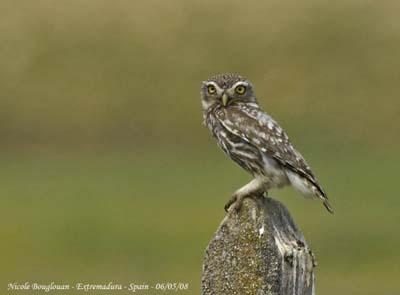
Little Owl
Athene noctua
Strigiforme Order – Strigidae Family
BIOMETRICS:
Length : 21-23 cm
Wingspan : 54-58 cm
Weight : M : 160-175 g – F : 165-205 g
DESCRIPTION:
Little Owl was the wisdom’s bird among the Greeks who engraved its effigy on some of their currencies. Little Owl was Goddess Athena’s companion, from whom it got its generic name.
PROTECTION / THREATS / STATUS:
These owls were introduced in New Zealand to control small birds become pests in orchards. They are now widespread in this country.
Introduced in Britain at the end of the 19th, Little Owl however was native from this country, with fossils records in Derbyshire from half million years ago.
The species is widespread in central and southern Europe, but numbers in many European countries have fallen in recent years.
Little Owl populations are vulnerable to pesticides, lack of nest-sites and harsh winters. Intensification of agricultural methods and industrialized farming practices may be largely responsible of declines.
Fr: Chevêche d’Athéna
All : Steinkauz
Esp : Mochuelo Europeo
Ital : Civetta comune
Nd : Steenuil
Russe : Домовый сыч
Sd : Minervauggla
Photographers :
Aurélien Audevard :
OUESSANT DIGISCOPING
Paul Guillet
Photos d’Oiseaux
Didier Buysse
Vision d’Oiseaux
Nicole Bouglouan
Text by Nicole Bouglouan
Sources :
HANDBOOK OF THE BIRDS OF THE WORLD Vol 5 by Josep del Hoyo-Andrew Elliott-Jordi Sargatal - Lynx Edicions - ISBN: 8487334253
THE COMPLETE BOOK OF BRITISH BIRDS – Written by “Royal Society for the Protection of Birds” experts - Préface de Magnus Magnusson - Michael Cady- Rob Hume Editors - ISBN: 0749509112
THE HANDBOOK OF BIRD IDENTIFICATION FOR EUROPE AND THE WESTERN PALEARCTIC by Mark Beaman, Steve Madge - C.Helm - ISBN: 0713639601
Pájaros de España (JL Beamonte)

Little Owl is fairly small and plump, with broad rounded wings and short tail. According to the range, the plumage varies from grey-brown or rufous-brown, to ochre-buff.
In all plumages, upperparts are spotted white whereas underparts are streaked brown of buff. Tail is barred white, with terminal white band.
The darkest birds have more conspicuous facial disks. The white eyebrow is long and broad. The facial disks are bordered by white line. A black half collar broken in the centre is visible below the cheeks.
The bill is yellowish to horn-coloured. Eyes are bright yellow. The fairly long legs are whitish and feathered.
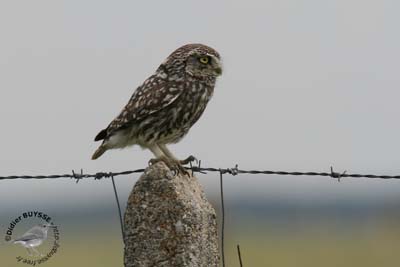
Both sexes are similar, with female slightly larger than male.
Juvenile is paler with more uniform plumage than adults. It is rather spotted buff than white, and streaks are narrower.
Spots may lack on the crown, and from back to uppertail coverts.
We find several subspecies (13) sharing the wide range of the species. These subspecies vary in plumage, spotting and streaking. The race “lilith” is the palest whereas the other races have intermediate colours.
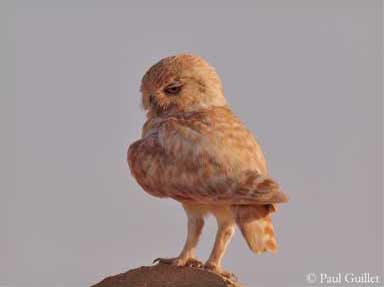
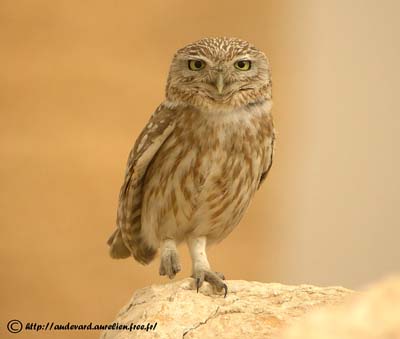
VOICE: SOUNDS BY XENO-CANTO
Little Owl typical call is a loud, clear mewing “kee-ew”.
The advertising call of the male is a mellow hoot, whistling “goooek” higher-pitched at the end. We can also hear other various calls, and a loud “hoo” in rising series of 5-10, sometimes more.
Female gives more nasal calls.
The alarm call is a shrill “kyitt-kyitt”. At dusk and during the first part of the night, these birds utter gloomy calls “tuuuu…” between them from place to place.
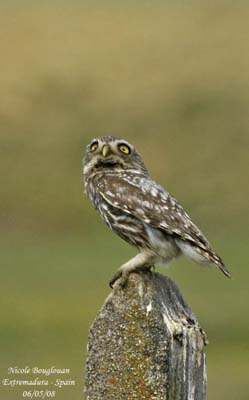
HABITAT:
Little Owl frequents several kinds of semi-open habitats such as steppes, stony semi-desert, cultivated areas, open woodlands, flat or hilly country with scattered trees, rocky slopes, gullies, orchards, ruins and villages.
This species avoids dense vegetation.
RANGE:
Little Owl lives in Europe and from eastern Asia to Korea, and North Africa. This species is resident in the temperate and warmer parts of its range.
It was introduced into Britain from Holland in 1889, but it is now very well established. It was also introduced in New Zealand in 1906 and 1910.
BEHAVIOUR:
Little Owl is often seen perched either upright or crouched on posts, fences, wires, rocks… When alarmed or excited, it stands upright and rapidly bobs head and body.
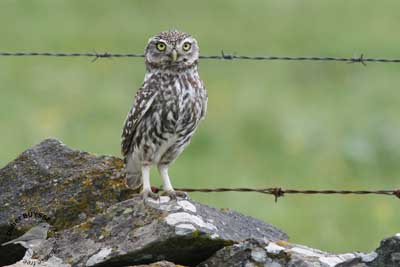
This species feeds mainly on small mammals and birds, but also on amphibians, reptiles and large insects. It also consumes plant items such as grass, leaves, small fruits and berries.
Little Owl hunts mainly at dusk and dawn, and during the first hours of the night. It usually hunts from perch, swooping down in direct flight onto the prey when detected.
It also may hunt on the ground. Thank to the fairly long legs, it can run easily for chasing preys.
The small items are caught with the bill. Insects such as beetles, and earthworms are swallowed whole. The larger preys are taken with feet.
Pellets accumulate below the favourite perches and nest-site.
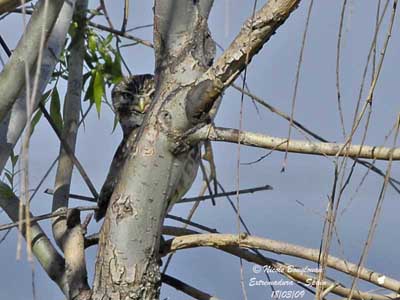
Little Owls are monogamous and pair-bonds last over the year, and often more. The typical courtship feeding by the male is frequent while the female gives begging calls. During this display, the male usually moves wings and body before copulation. Allopreening also plays an important role to strengthen the pair-bonds. Both mates utter calls while male approaches step by step.
Male establishes its territory in early February, singing its familiar “goooeeek” calls night and day. Courtship starts in March, when female responds to the male’s calls.
Little Owl is sedentary in its range and its territory is relatively small. According to the region, the pairs can be close to each other and give calls at dusk.
VOL:
Little Owl performs undulating flight over long distances. The flight includes active wing beats and short glides.
When hunting or chasing preys, the flight is more direct. Little Owl flies fairly low from the ground.
REPRODUCTION:
Breeding season occurs from March to August.
Little Owl nests in cavities, holes in trees or abandoned woodpecker nests, but also in holes in walls or buildings.
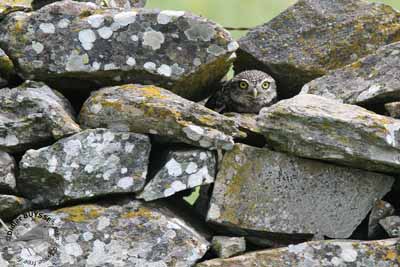
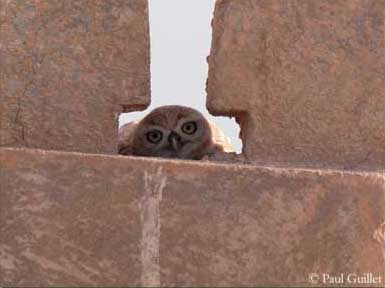
Female lays 2 to 6 rounded white eggs at two days intervals. Incubation by female alone lasts about 28 to 33 days. Male remains perched close to the nest, and feeds the female.
At hatching, the chicks are covered in thick white down. They are fed by both adults, mainly by the male. Young leave the nest about 26-28 days later, remaining in the surroundings of the nest. They really fledge 30-35 days after hatching. Both parents still feed them for one month more.
This species produces two broods per season.
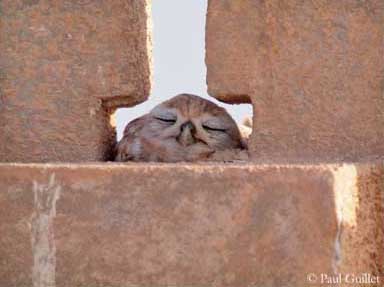
DIET:
Little Owl feeds mainly on large insects, snails, rodents and small mammals, small birds, frogs and lizards. It hunts at dusk and dawn, and during the first part of the night.
